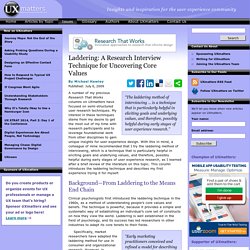

Questions of Priority. When Your Plate is Too Full : zen habits. By Leo Babauta Do you sometimes (or always) feel like you have too much to do and too little time to do it?

Consider an email I got from a student the other day: “… as the semester goes by, the harder it is to keep up with school. The thing is, I know I’d be able to do it if I didn’t have any extracurricular activities.
Understanding the Pareto Principle (The 80/20 Rule) Originally, the Pareto Principle referred to the observation that 80% of Italy’s wealth belonged to only 20% of the population.

More generally, the Pareto Principle is the observation (not law) that most things in life are not distributed evenly. It can mean all of the following things: 20% of the input creates 80% of the result20% of the workers produce 80% of the result20% of the customers create 80% of the revenue20% of the bugs cause 80% of the crashes20% of the features cause 80% of the usageAnd on and on…
Beware the Busy Manager. If you listen to executives, they’ll tell you that the resource they lack most is time.

Every minute is spent grappling with strategic issues, focusing on cost reduction, devising creative approaches to new markets, beating new competitors. But if you watch them, here’s what you’ll see: They rush from meeting to meeting, check their e-mail constantly, extinguish fire after fire, and make countless phone calls. In short, you’ll see an astonishing amount of fast-moving activity that allows almost no time for reflection. No doubt, executives are under incredible pressure to perform, and they have far too much to do, even when they work 12-hour days.
But the fact is, very few managers use their time as effectively as they could. The awareness that unproductive busyness—what we call “active nonaction”—is a hazard for managers is not new. For the past ten years, we have studied the behavior of busy managers in nearly a dozen large companies, including Sony, LG Electronics, and Lufthansa. Setting Priorities: Personal Values, Organizational Results.
This guidebook is available for eBook purchase and download from Apple's iBookstore; Amazon's Kindle; Google eBooks; Sony iStore, and other reputable distributors of eContent.
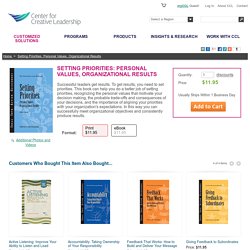
A Free Membership That Supports Your Leadership Needs - Join and Save Did you know that you can join the open and always-free myCCL at no cost and get a discount on this CCL Press Publication? CCL provides myCCL members with a 5% discount on CCL Press Publications like this just for being a member. Membership is complimentary in order to support our non-profit goal of connecting a world community of leaders and providing the best in leadership and leadership development for the benefit of societies world-wide. Does Your Calendar Reflect Your Life’s Priorities? Here’s a simple test to see if your important relationships and activities are priorities in your life.

Pull out your calendar and review your many tasks, appointments, and responsibilities. The Empty Container. Getting the Right Things Done. How to Prioritize. Prioritization Matrix. 7 Steps to Using Prioritization Matrices. Contributor: Steven BonacorsiPosted: 10/26/2011 12:00:00 AM EDT Rate this Article: (5.0 Stars | 2972 Votes) Lots to do but limited time and resources?
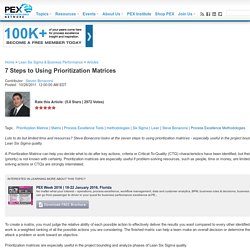
Steve Bonacorsi looks at the seven steps to using prioritization matrices - especially useful in the project bounding and analyze phases of Lean Six Sigma quality. A Prioritization Matrice can help you decide what to do after key actions, criteria or Critical-To-Quality (CTQ) characteristics have been identified, but their relative importance (priority) is not known with certainty. Prioritization matrices are especially useful if problem-solving resources, such as people, time or money, are limited, or if the identified problem-solving actions or CTQs are strongly interrelated. Error, please try again. * Required fields. To create a matrix, you must judge the relative ability of each possible action to effectively deliver the results you want compared to every other identified action. Purpose Your Day: Most Important Task (MIT) Deep Habits: The Importance of Planning Every Minute of Your Work Day. December 21st, 2013 · 153 comments Time Blocking The image above shows my plan for a random Wednesday earlier this month.
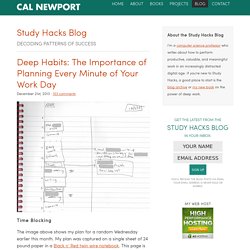
My plan was captured on a single sheet of 24 pound paper in a Black n’ Red twin wire notebook. This page is divided into two columns. In the left column, I dedicated two lines to each hour of the day and then divided that time into blocks labeled with specific assignments. Notice that I leave some extra room next to my time blocks. I call this planning method time blocking. Pursue Clarity Before Pursuing Results. August 29th, 2014 · 26 comments Shallow September.
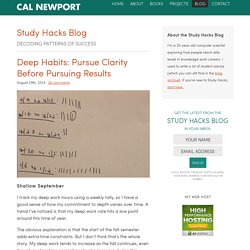
Laddering: A Research Interview Technique for Uncovering Core Values. By Michael Hawley Published: July 6, 2009 “The laddering method of interviewing … is a technique that is particularly helpful in eliciting goals and underlying values, and therefore, possibly helpful during early stages of user experience research.”
